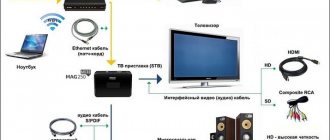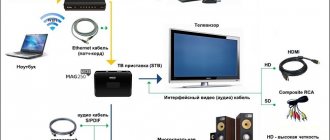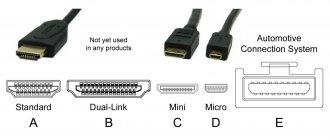IPTV is a data transmission technology over the IP protocol, which is developed for broadcasting digital television channels over the Internet. Should not be compared to Internet TV, which uses streaming video. Compared to classic digital television, IPTV has better picture and sound.
Interactive television has a number of advantages over other methods of television broadcasting:
- no additional hardware required (receiver, antenna);
- a number of additional services;
- function to continue viewing from where you stopped.
You can activate this service through:
- web browser;
- programs;
- a router that supports the corresponding function;
- set-top box with IPTV.
Let's look at how to set up IPTV through a router and set-top box.
Features of connecting IPTV on TV
You can traditionally watch IPTV for free on your TV, as well as on your computer, smartphone or tablet.
The IPTV connection method depends on the device. For example, on a PC or laptop it is enough to upload a playlist of TV channels.
The situation is different with outdated TV models. Since they do not provide modern “tricks” - an Internet connection, USB connectors, you will have to connect IP broadcasting using a receiver.
Today's Smart TVs are equipped with all the necessary functions: Internet, built-in entertainment services and cinemas. The set-top box expands user capabilities, allows you to control the viewing of TV channels and turn the TV into a media center.
Next, we’ll look at how to connect IPTV via a tuner directly from the router, as well as the nuances of connection on panels of different brands.
What is IPTV
The most common way to receive television is through a public antenna or private satellite. Despite the difference in the approaches of these two methods, technically the signal transmission occurs according to the same scheme. The subscriber's antenna or satellite catches the signal transmitted by the telecommunications company, processes it and broadcasts it on the user's TV. In essence, the viewer simply tunes the equipment to an already prepared continuous television broadcast.
IPTV works on a completely different principle. Data transmission in this television format occurs through file transfer, which is used when connecting to the Internet protocol. That is, television broadcasting providers use fiber optic cables, which are currently connected to almost every apartment building.
IPTV is not an analogue or variation of online TV. Despite the fact that the process of receiving and transmitting data between the subscriber and the provider is similar to an Internet connection, interactive television broadcasting works separately from this type of telecommunications service.
The main difference between IPTV and a regular Internet connection is that the signal transmission does not depend in any way on the performance of the World Wide Web. Television broadcasting is provided to the subscriber exclusively by the telecommunications company with which the contract was concluded.
Along with the peculiarity of signal transmission, comes the main distinguishing feature of IPTV - the interactivity of broadcasting. If in the most common methods of television connection, a common antenna or satellites, the user received a ready-made television signal, then in the case of IP television the subscriber is provided with data that contains the TV format. This means that the user becomes an accomplice in the broadcasting process.
Telecommunications companies that provide IPTV services offer their clients control over the received signal. From now on, users can stop television broadcasts, participate in interactive programs, and even rewind the necessary fragments of television programs.
Stopping the broadcast even works with live programs.
How to connect IPTV via set-top box
Let's start with how to connect IPTV to a TV using a digital tuner.
The described sequence is suitable for any model.
The physical connection of the IP TV box is performed in the off state.
- Connect the HDMI cable to the appropriate connectors on the set-top box and TV. If you are connecting via an RCA cord, connect it to the AV output, and the “tulips” to the TV.
- Insert the Ethernet patch cord into one of the LAN ports of the router in the receiver unit.
- Connect the power supply.
- On the remote control, press the “Setup” button to open the tuner interface.
- Go to the “Advanced Settings” section, set Internet and video playback parameters.
- Separately, you need an m3u playlist of TV channels to dump these files onto a flash drive.
- Then go to the “USB” menu and run the player installation file from the drive.
- After installation, open the player and click “Add playlist” and “Select file”. Find the file on the flash drive, click “Ok”. Channels are displayed in a general list. Click the channel icon to start playing.
What you need to watch IPTV
The equipment that the user will need to watch IPTV will differ from the chosen connection method. There are several options for possible installation of IP television, so they should be divided according to several criteria:
- connection type - wireless or using an ethernet cable;
- signal reception equipment - router or TV set-top box;
- TV broadcast playback device - desktop computer or TV.
Depending on the type of connection chosen by the user, the device for receiving the signal and playing TV broadcasts, the equipment necessary for the correct operation of IPTV will change.
Despite these nuances, for each IPTV connection, the subscriber will need an ethernet cable. This wire is provided to the user by the provider upon connection. The television broadcast signal will be transmitted through this cable.
Next, the ethernet wire can be connected to two types of equipment to receive data: a Wi-Fi router or a TV set-top box. The connection follows the same principle - the cable must be inserted into a special connector, which is usually located on the back of the device.
Depending on the selected signal receiving equipment, the further path of the ethernet wire will differ.
The cable path may not continue at all if the user decides to use a wireless connection and watch TV using a laptop. Or continue from the router to the subscriber’s personal computer using an ethernet cable if the client’s PC does not have a wireless connection.
Also, for a desktop computer and laptop you will need special software - a multimedia player. Most often, this software is provided by the telecommunications company providing the service. However, in some cases, the user needs to independently download applications to watch IPTV.
The subscriber is able to independently connect a personal computer to a TV using an HDMI cable. However, in this case, video from a PC will be broadcast on TV, so managing the broadcast becomes extremely inconvenient.
To connect directly to the TV, it is recommended to use special set-top boxes. They process the received signal and transfer it to the device the user needs.
It is worth noting that for IPTV to work correctly, the TV must have a built-in SMART TV function. In the absence of this mode, IP television simply will not be able to start broadcasting.
As can be seen from the above, there are many options for connecting IPTV, which require a variety of equipment. Therefore, to begin with, it recommends deciding on a specific method, and then selecting specific devices for watching IP television for it.
How to connect IPTV through a router
The second way to use IPTV on a TV with a smart function is to connect the TV directly to the router.
We will show you two methods: via a network cable and Wi-Fi.
Let's start with the wired connection.
- Connect one end of the LAN cable to the panel port, the other to the router connector that is highlighted in the settings.
- In the “Quick Settings” menu, select “Network” and go to “Wired Connection”.
- Click the “Change” button and check the “Automatic” checkbox.
- Click “Connect”.
Information about the local network will be sent from the router to the TV, and the connection will be established automatically. There is no need to enter anything manually.
The wireless connection is made in the “Connect to a Wi-Fi network” section of the menu. Available lines are displayed in a list. Select your local line, enter the password, click “Connect”.
Internet connection has been established.
Setting up the set-top box
The very first thing you need to do is buy yourself an Android set-top box, which is a device that replaces a cable or satellite dish. Android-Box is the core of your IPTV setup.
They have features that enable the media player as well as the applications needed to display the content. In addition, there is built-in Wi-Fi for connecting to a router. In other words, any TV turns into a Smart TV when an Android set-top box is connected to it.
Also, for IPTV to work you will need an m3u playlist. They are provided by various suppliers, for example, the Soborka provider, Tricolor, IVI and others.
Connection for LG TVs
Let's take a closer look at connecting digital TV of popular brands.
Let's see how to set up IPTV on an LG TV.
- To watch IPTV for free on your LG TV, download one of the players: “Vintera TV”, “Peers TV”, “SS IPTV”.
- Register in the “LG Content Store” service.
- Search for media player in the market.
- Click “Install”.
To watch IPTV on your LG Smart TV, simply open the installed application. Built-in channels are displayed on the main screen.
If these channels are not enough, download the m3u playlist.
- Find the desired playlist through the search engine and copy the address to the flash drive.
- Insert the drive into the USB connector and start the player.
- In “Settings”, find the “External playlists” section and click “Add”.
- Select “USB”, click on the playlist file and click “OK”.
- The new list will appear in a separate folder.
PC
You can also watch television channels via IP protocol on your computer through any player that supports the technology. The most popular are VLC and IPTV player - highly specialized and easy to set up.
We download it from the official website borpas.info, install it without downloading additional components, and launch it. A separate window with the contents of the playlist displays a list of television channels.
Connection on Samsung TV
We tell you how to connect IPTV to a Samsung TV.
Setting up IPTV on a Samsung Smart TV begins with setting network parameters.
- Open the “Network Status” section in “Settings”.
- Select “IP Settings”.
- In the “Configure DNS” field, enter the value 85 17 30 89, click “Ok”.
Paid IPTV subscriptions on Samsung TV are available in the native application “Divan TV” and “nStreamPlayer”.
For free use, the Samsung Apps store contains separate TV channel applications and players with an installed list. Download the desired application from the platform and enjoy watching “digitals”.
How to set up IPTV on PC
You can also watch IPTV via a PC, this is done using VLC Player. It is an open source multimedia player that can play any media files including IPTV channels.
After you download and install the player, open VLC Player. You need to click on the part at the top of the screen that is called “Media”.
Then click on the “Open Network Stream” tab.
Now you will see the message: “Please enter a network URL.” Here you need to enter a special m3u link. Then click on "Play".
The small blue circle will begin to spin, giving the impression that the program is not responding. However, you just need to wait a minute or two for the player to load all the channels.
Connection on Philips TV
Installing IPTV on smart panels from this company is not difficult.
- In the main menu, open the “Configuration” section.
- Select “Network Connection” and “Wired”.
- Go to “Network Settings”, select “Static IP Address”.
- Find “IP Configuration”, in the “DNS1” line write down 178.209.065.067.
- On the main screen, click the “Net TV” shortcut, select the “Stream” or “Ivi” application.
- Click Add.
After this, the setup is completed and the programs are available for use.
Using Proxy
When broadcasting IPTV, problems are detected - poor image and sound quality. To avoid such problems, set up a UDP proxy on your computer or router. When the function is activated in the router, watch TV shows on your tablet, smartphone and other devices.
Algorithm of actions:
- from Play Market.
- Activate.
- Select “UDP-multicast Interface”, then “HTTP Server Interface”.
- The IP address of the interfaces must match the IP address of the network connection. To do this, click on the network connection icon: Windows 7 – “Status” – “Information”; Windows XP – “Status” – “Support”.
- Enter the IP addresses in UDP-to-HTTP Proxy.
- Save, install and run.
- From the menu, select “Application Settings”, go to “Proxy Settings”, enter the IP address and port set in UDP-to-HTTP Proxy.
- Select the Proxy server type.
- Activate.
Interactive television IPTV has a modern design and a wide range of capabilities. With the use of any multimedia content playback devices, watching television moves to a new level of convenience and comfort.
Connection on Sony Bravia TV
The IPTV function on the Sony Bravia TV is activated through the built-in “Opera TV Store” browser.
- On the remote control, press the “Home” button, go to this application.
- Here, find the “Tools” tab and open the “URL Loader” program.
- In the address bar write operatv.obovse.ru\2.5\, click “Go”.
- The “Forkplayer” program page will open with icons of channels, movies and TV series. With one click, turn on news, educational or entertainment content.
Setting up IPTV on a Sony Bravia TV is done in another way. When you switch to the mobile version of a bookmaker’s website, the system often automatically prompts you to download an application for different operating systems. mobile version of bookmaker Usually a tab with this message appears at the very top in a prominent place.
To do this, you need to transfer the installation file to a USB flash drive and run it on TV. After that, add a playlist of channels.
Working with the application is simple: the channels are distributed into thematic blocks, under each there is a program guide.
Kuleshov Vyacheslav
I have more than 10 years of experience in the IT field. I am engaged in designing and setting up commissioning works. We also have extensive experience in building networks, system administration and working with access control and video surveillance systems. I work as a specialist in .
What are IPTV playlists
Standard analog television provides its users with a continuous television signal. This type of information transmission is similar to radio broadcasting. However, IP television provides its subscribers with a completely different format of television broadcasting.
Companies that provide IPTV services provide their clients with special playlists. This is specially encoded data that enters the processing application or multimedia player and provides the subscriber with access to the TV channels he needs.
Typically, the playlist is provided to the user by the provider. However, IPTV makes it possible to independently connect to already created playlists and even create your own. Most often, these paths can be found on the Internet in absolutely free access. This demonstrates another global advantage of interactive television - the complete absence of monthly subscription fees and payments for additional packages of television channels.
The main advantages of IP television over other types of TV broadcasting.
- There is no need to purchase additional devices in the form of antennas, receivers or cam modules. Internet access is sufficient.
- The presence of a timeshift function (delayed recording), that is, the ability to pause the channel for a while and continue watching from the same place.
- Additional (English: Video on Demand (VoD) (IP-UNICAST) - a system for personal delivery of TV programs, videos and films to the subscriber via the Internet or iptv channel from a media server in a variety of quality and media formats - MPEG, AVI, FLV, MKV or QuickTime )
As a rule, there are currently two main ways to receive IP television:
- Using an IPTV set-top box, which is usually rented by the Internet provider itself or you purchase it at your own expense.
- Through installation on smart devices such as personal computers, tablets, smartphones, Android set-top boxes and smart TVs, etc. specialized applications, setting them up and adding a list of iptv channels to them. To watch IPTV on various devices, the following applications are usually used: -Player, IPTV Player, PC Player, OTT-Player, etc.
How to set up iptv on a computer
First, install the latest version of VLC player on your computer from the official website
The tool for viewing iptv channels on a PC is the IPTV Player program. For trouble-free use and troubleshooting connection and configuration problems, you need to add it to the antivirus exclusion list, allow the program all network connections through the antivirus firewall, or, as a last resort, disable it completely.
A well-proven IPTV player with a good shell and easy navigation is suitable as a basic program for watching IP-TV on a computer. Link for downloading and subsequent installation on a PC: .
When installing an IPTV player selectively, do not forget to uncheck additional checkboxes from the installation items “Yandex browser”, etc.
The general view of the player and its interface is shown below:
List of IPTV channels
The most common IPTV channel list format is m3u. This file is a playlist of iptv channels for playing them, for example, through a basic Windows Media player. The list and content of playlist channels does not always correspond to the user’s interests, but it can be easily edited through a regular text editor - for example, “notepad++”. Through this editor, you can easily remove unnecessary channels, leaving only what you need. This is basically what setting up an IPTV channel list in m3u format is all about.
When you first launch the IPTV player, you will need to select a provider from the list or load a list of IP channels from the Internet into the IPTV player by selecting the following item in the player menu:
“I have a web address for a list of channels”
And insert the url of playlists of iptv channels. Let's start in descending order from stable paid channels to less stable free ones:
Resources where you can get paid m3u playlists of iptv channels:
1. — paid iptv, on-demand tariffication - about 2-3 rubles per hour.
2. is another paid IPTV resource with high-quality channels of various genres. Registration is required; a link to the playlist will be available in the user account after payment.
Resources where you can download free m3u playlists of iptv channels:
Free playlists are frequently updated, so it is advisable to register on the websites that provide them or join closed communities in VKontakte groups, which can be found through a search.
- . This resource provides the ability to search and download IPTV playlists from various cable operators in Russia;
- . The most current and free IPTV playlists with descriptions;
- . A well-known forum with a large number of custom IPTV playlists;
- . Updated free IPTV playlists with descriptions;
- . A good resource with free playlists. According to some information, the information on the resource has not been updated since 2021, but it’s worth a try. Go to the site, then select the “Russia” tab, then click on the green “Download Russian.m3u” button. We save the resulting playlist and add it to the iptv player (for example, an IP-TV player, this is done by going to Settings - General, selecting the downloaded playlist file, or adding a self-updating list of channels in a special URL field);
- Ukrainian resource dedicated to IP television, which contains links to iptv playlists of numerous Russian Internet and iptv providers;
- . This resource has a self-updating iptv playlist of 400 TV channels, Russian and foreign television with channels of various genres and topics..
To change the list of channels in this IPTV player, you need to check the “all settings” box in the settings (gear icon)
Then, in the “channel list address” column, add the url of paid or free, self-updating or static playlists that are available on specialized Internet resources.
Setting up a router to watch IPTV
The main problem that users may encounter is the correct configuration of a wi-fi router for stable operation of IPTV. Note that not all router models natively support this feature.
List of routers with IPTV support
Important! To clarify the models of routers that support Multicast or IGMP (Internet Group Management Protocol) functions, you can contact the support service of your Internet or iptv provider or find the information you are interested in on the router by visiting the manufacturer’s official website.
Routers for IPTV over Wi - Fi
Currently, for stable operation of IP-TV via Wi-Fi, wireless routers with Wi-Fi data transfer speeds from 54 Mbit/s series-G, from 150 Mbit/s series-N and from 300 Mbit/s series-N are suitable, as well as even more modern models.
It is worth immediately taking into account that connecting IP-TV via Lan cable and via a wireless connection are methods of different implementation of IPTV connection in a house or apartment.
Your router is entirely responsible for the ability to process and transmit IPTV over a wireless connection. There are a huge number of routers that theoretically can and should support the ability to watch IPTV via a WI-FI network, that is, over a wireless connection and without an IPTV set-top box, but in reality, for more or less stable and uninterrupted operation of the router, it is recommended to update its firmware to the latest or alternative software from independent authors - firmware from tomato or from oleg, etc.
Sometimes it is possible to watch IP television via Wi-Fi only without encryption, that is, only when the Wi-Fi signal is not encrypted and the connection to the network is made without a password, but this option is very risky, since there is a possibility of your local network being hacked with subsequent using your personal data and passwords. Therefore, it can only be used if the Wi-Fi signal from your router has a limited radius within your apartment or house.
Another important factor is stable wireless network coverage. Some may need to fine-tune the Wi-Fi network and activate the appropriate functions, while others may additionally have to move the router to a more favorable location in an apartment or private house to avoid “glitches” and “image artifacts.” » with a significant distance of the IPTV client - laptop, tablet, Android TV set-top box, etc., from the source of the wi-fi signal, that is, the router.
Activating Muiticast or IGMP function on a router or ADSL modem
Having configured the list of iptv channels and launched the program, you can immediately start watching them since no additional settings are required - the program itself will build a list of channels from the playlist and update the TV guide, except for a small but - you may need to enable broadband broadcasting support in the settings of the router or multicast.
IP TV operates on the principle of multicast broadcasting. The media data stream is sent to all lan network devices connected to the router, router or adsl modem simultaneously. For stable operation of a router or adsl modem, eliminating problems with overloads and freezes, it must support the Muiticast or IGMP function.
This function may have different names for different devices: Multicast broadcasting, Multicast routing, IGMP Proxy, Multicast streaming, MultiStreams, etc. Certain models of routers may have a setting such as “broadband broadcasting over wi-fi”
The IGMP standard is designed to work in IPv4 networks. IPv6 networks usually use the Multicast standard.
If you are sure that the router model supports the Multicast function, but there is no corresponding item in the IPTV/IGMP settings in the router or modem, then you need to update the device firmware from the official/unofficial website of the manufacturer.
The table below shows examples of activating this function on various router models.
Setting up a router for an IPTV set-top box
If, when using a computer, broadcasting of video images and decoding of the signal is carried out using the installation of IPTV players, then in IPTV set-top boxes, for these purposes, hardware is used for electronic decoder circuits, the task of which is to convert the digital signal into an analog image for TVs or monitors.
Therefore, if you use an IPTV tuner to watch IPTV channels, you need to set a separate router port for the IPTV set-top box, and then add a playlist of IPTV channels to its settings.
Allocation of a LAN port for connecting an IPTV set-top box
- Delete the WAN connection/connection;
- Select the “WAN” connection in the “Connections” submenu in the “Network” menu tab;
- Click the “Delete” button at the bottom of the window that opens for the selected connection;
- If everything is done correctly, this connection will no longer appear in the list of available connections. Be sure to save all changes;
- Then we need to connect the LAN port to the WAN port - select an unoccupied LAN port, then in the “VLAN” section of the “Advanced” menu, activate the “VLAN LAN” item;
- For convenience, we select the 4th LAN port, although you can choose any one at your discretion and delete/uninstall it;
- After this, we will have all other LAN ports as active ports, which will correspond to the numbers on the back of the router/router, save these changes and reboot the device;
- The next step is to add the selected and uninstalled LAN 4 port to the WAN VLAN;
- Next, select the “save changes” button. After all changes made to the device settings are saved, we reboot the router/router. Then we will have the option to add and configure port No. 5;
- Now ports 4 and 5 are in the VLANWAN subnet and to create a WAN connection just click the “Add” button
This router/router setup is available if your Internet provider supports the DHCP function, which will automatically assign an IP address to the client. The DHCP function is available on almost all modern cable Internet providers. After completing all the settings described above and connecting to the Internet provider’s network, LAN 4 port has now become available for connecting an IPTV set-top box since it duplicates the WAN port.
The procedure for configuring specific router models for IPTV broadcasting when using an IPTV set-top box.
TP-link models:
- Enter the default login address into the router's web interface in the browser line.
- Username – admin, password – admin.
- Section "Network", subsection "Bridge".
- Line – “LAN port, in “Bridge” mode with WAN” select the desired port for the IPTV set-top box.
ZyXEL models:
- In the browser line, enter the default login address to the router’s web interface.
- Username – admin, password – 1234.
- On the left in the menu, select “Home Network”, subgroup “IP-TV”.
- “Assign LAN connector”, item “TV port mode”.
- Then, in the “Receiver Connector” menu, set the desired port.
NetGear Models:
- Enter the default login address into the router's web interface in the browser line.
- Username – admin”, password – password.
- On the left side of the “Quick Jump Menu”, select the “Settings” submenu, and then “Internet Port Settings”.
- In the sub-item “Redirect the stream for the set-top box to”, enter the desired port.
ASUS models:
- In the browser line, type the standard login address to the default router web interface.
- Username is admin, password is admin.
- On the left side of the page, select “Local Network” from the list.
- In the window that opens, select “IPTV”. In the “Select STB port” line, select the required port for the IP Set-Top-Box from the possible ones.
The username and password settings correspond to those set in the default router. If the passwords for logging into the router’s web interface were changed by the user independently, then they must be used.
IPTV on Android devices
As mentioned above, more and more Internet providers are giving their potential and actual clients, in addition to the Internet, the opportunity to watch television via the Internet, namely, they provide an IP television service. Setting up IP television and viewing it on a computer is described above and does not cause any particular difficulties in setting up, while for viewing IPTV on wireless Android devices such as Android TV players, tablets and smartphones, there are certain configuration nuances for comfortable viewing of IPTV.
In order to view IP television channels provided by your Internet provider or add playlists with paid or free channels from any other source on the Internet, you need to install a special application on your smartphone, tablet or any other Android device - IPTV player .
You can download it from Google Play (Play Store, Android Market). This application works without problems with m3u format playlists, allows you to download them both from the Internet by adding links to the playlist with channels, and by specifying the playlist file with channels on local media, an SD card, etc. After adding a file and downloading channels, they are played using video players such as MX Video Player, VLC media player, etc. installed on an Android device. After installing this application, you need to configure it.
Setting up an IPTV application on Android devices.
IPTV service from the provider
When connected to an IPTV service from an interactive television or Internet provider and viewing it on wireless Android devices, in addition to installing an application and player for IPTV, a URL or playlist file from the provider, an important condition for stable viewing of iptv is the correct configuration and connection of the Android device via WiFi network to a router that is connected to the network of the provider providing this service.
Adding an address or playlist file with a list of channels.
To add a playlist with channels from an Internet provider or IP-TV provider, you need to select the “Playlists” section in the program menu and add the URL of the file provided by them.
If you want to add your own playlist with a list of channels to the application, then this can be done in two ways:
- Add a link to a free playlist with channels from Internet sources in the same way as adding a playlist with channels from an Internet provider or add your playlist file in the “Select file” item of the application menu from the flash memory, SD card of the flash drive of the Android device, having previously created it or by downloading it from the Internet and saving it in the device’s memory. You can also place the downloaded or created playlist file with channels in m3u format into a regular folder created on a flash drive or SD card, for example, with the name “iptv channels”. And in order to ensure that our file is not deleted after exiting the Android IPTV application, you need to create an empty file in the same folder with the name .nomedia (dot required)
- use, for example, the Yandex Disk by uploading a file with a playlist there and copying the public link to it to the clipboard. Then add the link address as in the case of a playlist from an Internet provider.
What is a UDP-HTTP proxy
Sometimes it becomes necessary to convert a UDP multicast into a TCP unicast , that is, you need to configure a UDP proxy . This is usually done if there are viewing problems when playing IPTV - freezes, image artifacts, picture loss, sound distortion, etc.
UDP-to-HTTP Proxy is used to convert UDP -Multicast ( multicast, multicast , multicast ) IPTV traffic
in TCP - U nicast (unidirectional or one-way data transmission), and specifically transmission to a single recipient - an IPTV client via http traffic.
This procedure is necessary for stable viewing of IP television via Wi-Fi , NAT, smartphones and PDAs, household and Android TV players and game consoles.
This traffic conversion can be accomplished using the UDP to HTTP utility. The application is installed on a PC and activated on it with the obligatory connection of the computer via a local network and a wireless connection of IP clients. The main condition for such a connection is that the computer is always on (client computer or server on the local network), or you need a router with the function of traffic conversion technology - udpxy . In this case, the conversion of UDP to HTTP traffic will occur in the router itself if it is correctly configured and this function is activated .
If you own a Wi-Fi router with built-in UDP proxy support, then just activate this function in the router settings and the problem with wirelessly watching channels through the IPTV application on a tablet, smartphone and other devices will be solved. But in practice, for this function to work as it should, you may need current or even alternative router firmware, which not every entry-level user can do.
If, when watching IP television via wi-fi on Android devices, image and sound artifacts appear, the stream playback is unstable, the picture freezes and freezes, then most likely the router cannot cope with its task and does not have UDP proxy support . Therefore, for comfortable viewing of IPTV, we will need to create a UDP proxy using any computer on the local network connected to the LAN connector of the router via an Ethernet cable. To implement this function, a special application “UDP-to-HTTP Proxy” is installed on the computer.
Setting up a UDP-to-HTTP proxy in the application on a PC
The UDP-to-HTTP proxy program for Windows is available at: download and run.
The UDP-to-HTTP proxy application for Linux can be downloaded here:
In the main program window, for proper configuration, just enter 2 IP addresses in the “UDP multicast interface” and “HTTP server interface” columns:
Typically, the multicast interface is determined automatically by the application, and then an identical HTTP server interface must be selected. In this case, the values of these two fields coincide and correspond to the IP address of your computer on the network through which it is connected to the router.
If the computer's IP address is not determined automatically by the program, then to correctly determine the IP address of your computer on the local network, depending on the installed Windows OS, do the following:
How to find out the IP address of a computer on a local network?
In Windows 7, right-click on the network connection icon (next to the clock), select the pop-up menu item “Network and Sharing Center” and then “Change adapter settings”. Then in the context menu of your connection, select the “Status” item and in it the “Details” button:
In Windows-XP, click on the connection icon, select “Status” in the context menu, then the “Support” tab:
To final configure and activate the application, select the IP address of the network connection of our computer in the HTTP Server Interface , then the “Save” and “Run” buttons
When launched, a window with a black screen will appear, which we simply minimize.
Good to know:
To run the UDP-to-HTTP proxy program on your computer as a service with automatic start when the computer boots, you must click the “Install” button in the program.
If any problems arise when running the UDP-to-HTTP proxy program on your computer, you need to make sure that it is not blocked by an antivirus or firewall. To do this, it is advisable for the program to “Add a firewall exception” and add it to the exceptions of your antivirus. Yandex or Google will tell you how to do this.
Setting up a UDP proxy in the IPTV application for Android devices:
After you have installed and configured the UDP Proxy program on your PC, in the parameters of the IPTV application on your Android device, in the “UDP Proxy Settings” item, you must check the “Use proxy” box and enter the identical IP address and port that are specified in the UDP program -to-HTTP Proxy on PC, and then select the type “UDP-to-HTTP proxy (Windows)”. If you are using a proxy on a router or Linux, then select the “UDP-to-HTTP proxy (Linux)” type.
Now all the settings are complete, you can start watching your favorite channels.
Sometimes when you try to watch an IPTV channel, a message may appear stating that you do not have MX Player installed. To fix this problem, just click on the “Install” item and select “Play Market” if the Android system asks what to use. The MX Player application page on Google Play will open, then select “Install”.
You don't need to use MX Player to watch channels. To do this, in the application settings in the “Video Player” item, you can select another player or a specific application with which you will watch the video.
Also, using the “Selected by the system” item, you can provide a choice to the system so that you can select a video player every time you start watching the channel.
In previous articles about IPTV television, we analyzed and explained the procedure for setting up channels from various Internet providers providing IPTV services. Now we will look at how to set up IP-TB channels on a computer if the provider does not provide a service for broadcasting iptv channels. Moreover, the channels can be either federal, by analogy with the channels of the first and second multiplexes of digital terrestrial television, or thematic VIP channels from paid or free services providing these services.
Setting up IPTV channels on SmartTVs
With the advent of TVs with Smart TV functions, their owners have the opportunity to watch TV programs not only via cable, satellite or terrestrial broadcasting, but even via the Internet using IPTV applications or widgets, and absolutely free.
Below we will try to explain in general how you can install an IPTV application on your TV and set up viewing IP channels on it.
Using the example of one of the popular and shareware IPTV applications - Simple Smart IPTV (or SS IPTV ), we will look at setting up iptv television on a SmartTV TV.
How to connect and configure free iptv channels on a SmartTV?
If you already own a Smart TV, then to set up iptv channels you need the following:
- Connect the TV to the Internet via LAN cable (preferred) or WiFi
- Computer or Notebook for setup
- Register in the catalog/app store for your Smart TV
- Install applications to watch iptv channels
- Add playlists with channels
The number of iptv channels can only be limited by your imagination as there are a huge number of options for free and paid playlists on the sites listed above.
Installing and configuring the IPTV application on SmartTV TVs
First, you need to make sure your TV is properly connected to the Internet. Connecting to the Internet can be done via a LAN cable or via a Wi-Fi connection. Then you can start installing and configuring the IPTV application.
- In the catalog/app store in the smart menu of the TV (registration may be required), download and install the SS IPTV application.
- Select the gear icon in this application and get to the settings menu.
- Add the previously downloaded channel playlist using the links above and enjoy watching.
Initially, the SS IPTV application does not contain any channels or playlists with them. This is how it should be, since channels and playlists with them must be added to it yourself.
There are two options here:
- Enter the playlist URL in the settings yourself
- Connect a Smart TV via a local network via a router or via Wi-Fi to a laptop or PC and add/edit/delete playlists through it.
There are no restrictions on the number of channel playlists added from external sources, while only one playlist is provided for internal purposes. Adding external playlists occurs by analogy with other devices and applications for iptv - from sites that provide these lists of iptv channels for free or from the sites of IPTV providers on a paid basis after registration. An internal playlist can be added using a code directly from .
Added playlists will be stored in the “ Settings ” menu and displayed on the screen as tile icons. When you select the icon at the bottom of the screen, a list of IP channels appears.
To download a playlist via an external link, in the “ Content ” menu subcategory of the SS IPTV application, select “ External ” and then “ Add ”. After that, come up with a name for the list and indicate the URL to it.
You can do whatever you want with external playlists - edit, delete, transfer to friends, post for free access, etc.
To obtain an internal address for a list of iptv channels, you must select the “ General Settings and click the “ Get code ” button.
The validity period for the activation code and its entry using the “Add” button in the playlist editor is one day, after which you can request the code again.
You can also use programs such as PeersTV Vintera.tv or forkplayer to watch IPTV on Smart TVs. Installing and configuring all these applications for IP-TV is similar to the settings for SS-IPTV, with the only difference being that there may be differences in the download server address (on Samsung) and other minor details that are easy to figure out on your own.
Where to download IPTV playlists
Of course, to watch IPTV a person will need to find a working playlist. And this is not an easy task, since links to streaming videos are constantly blocked by copyright holders. But at the same time, you can find a valid playlist without much difficulty using any search engine.
Links to playlists are regularly updated in the following sources:
- https://iptvm3u.ru/list.m3u;
- https://smarttvnews.ru/apps/iptvchannels.m3u;
- https://webarmen.com/my/iptv/auto.nogrp.m3u;
- https://iptvm3u.ru/hdlist.m3u.
If you follow any of these links, you will most likely be able to download a working playlist. Alternatively, you can link to it in the app you use to watch on your TV.
IPTV - pros and cons
Interactive television has a number of advantages. Firstly, this is an unlimited number of TV channels - whichever list the user downloads, the amount of TV content he will receive . These can be federal or regional channels, as well as additional ones at the user’s request, including programs on a narrow topic or educational ones.
The next advantage of IPTV is that it is free. Lists of television channels are downloaded from the Internet.
On a note! Most Internet providers often provide the opportunity to watch interactive television as a bonus to their service packages without charging additional fees.
Compared to analog television, IPTV provides picture and sound of significantly better quality. Even digital channels in HD format are available to the user, although there will be few of them in the free package of interactive television provided.
IPTV does not require an antenna or cabling. All you need to transfer your TV to digital television via the Internet is a stable high-speed connection and the Smart TV function. If the latter is missing, you need to buy an IPTV set-top box.
Another advantage of IPTV is that it can be configured on an unlimited number of devices. If the Internet connection speed allows, the user can connect several TVs to the network and make digital television via the Internet.
Important! The disadvantage of IPTV is that comfortable viewing of television channels is impossible at low Internet connection speeds. Data transfer should not be slower than 10 Mbit/s.
Possible problems and ways to solve them
If, after completing all the steps described above, the user does not see a list of channels, the reason may be that there is no network connection. You need to make sure that the Internet is not disabled for any reason, and then check the device settings.
Another reason why there is no list of channels may lie in a non-working or outdated playlist. In this case, you should ask your provider or look online for a new, up-to-date list.
So, knowing what needs to be done for the TV to show interactive digital channels, you can set up IPTV yourself at home. To do this, you will need an uninterrupted high-speed Internet connection, an IPTV set-top box or the Smart TV function in the television panel.
Advantages and disadvantages
The advantages of the program include:
- minimalistic interface;
- Availability of Russian language;
- completely free;
- wide functionality;
- broadcast recording;
- ability to pair with Smart TV, for example, Samsung;
- ability to control the program from a smartphone.
Unfortunately, there are also disadvantages here. Of the existing 30 channels on one provider, only 10 worked for us; for the purity of the experiment, we tried others, the situation did not change. In particular, Rostelecom, Luganet and Novotelecom failed to launch. Green Point Stavropol also did not want to work. No matter how hard we tried, there was no image. Other programs launch instantly.
[ads-pc-1]
The fact that the channel does not work depends on the program; the reason for the inoperability of TV programs lies on the side of the providers. Other TV shows launch correctly, which means the application itself has no problems











